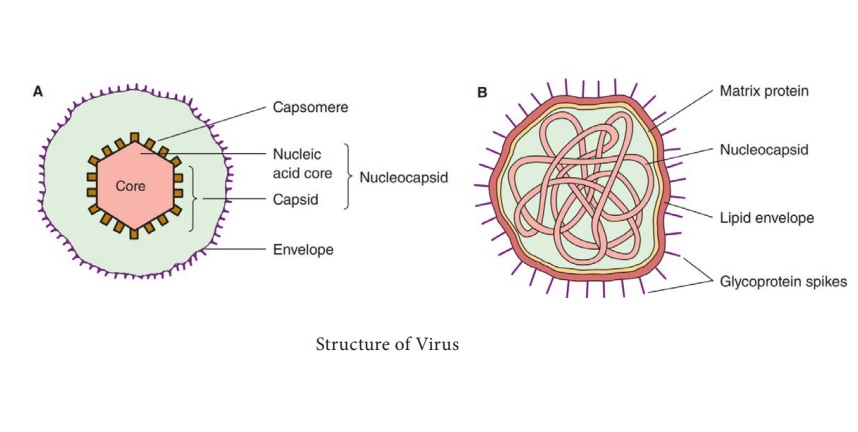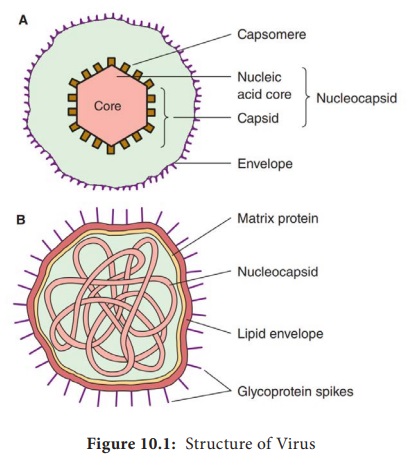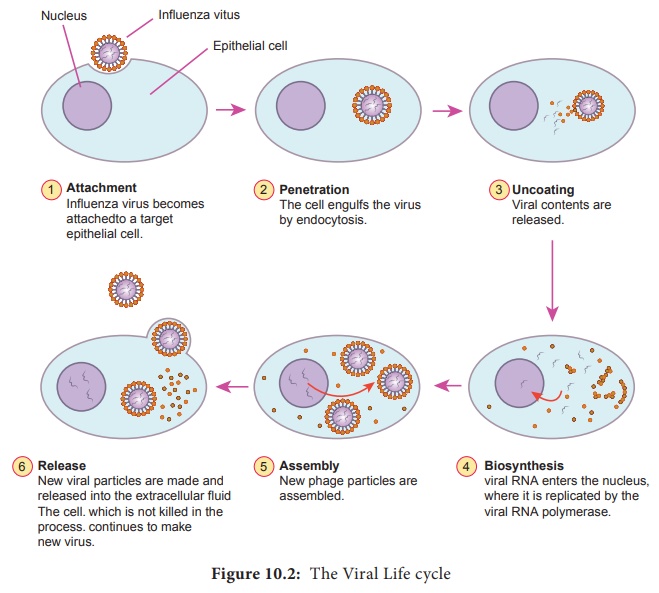Chapter: 12th Microbiology : Chapter 10 : Medical Virology
Evolutionary Origin of Viruses

Evolutionary Origin of Viruses
The
origin of viruses is not known, but two theories of vital origin can be
summarized as follows;
i. Viruses may be derived from (DNA or RNA) nucleic
acid components of host cells to
replicate and evolve independently.
ii. Viruses
may be degenerate forms of
intracellular parasites.
Morphology
Size
Viruses
are smaller than bacteria, known as filterable viruses vary widely in size. The
largest among them is the Pox virus measuring about 300nm. The smallest virus is Parvo virus measuring about 20 nm.
Structure and Shape
The
virion consists of nucleic acid surrounded by a protein coat, the capsid. The capsid with the
enclosed nucleic acids is known as the nucleo capsid.
The capsid is composed of a large
number of capsomers. The functions
of the capsid are to protect the nucleic acid from the deleterious agents and also to introduce
viral genome into host cells by adsorbing readily to cell surfaces (Figure 10.1).
Two kinds of symmetry encountered in the virus are icosahedral and helical.
Virions may be enveloped or non
enveloped (naked). The envelope or outer covering of viruses is derived
from the host cell membrane when the progeny virus is released by budding. The
envelope is lipoprotein in nature.
The lipid is of host cell origin
while the protein is virus coded. Protein
subunits may be seen as projecting
spikes on the surface of the envelope
and are known as Peplomers.

Overall shape of the virus particle varies; mostly animal viruses are roughly spherical. Some are irregular and pleomorphic. The rabies virus is bullet shaped, Ebola virus is filamentous and pox viruses are brick shaped.
Chemical Properties
Viral protein determines the antigenic specificity of the virus. Some viruses contain small amounts of carbohydrates. Most Viruses do not possess any enzymes but retro virus has a unique enzyme, such as RNA dependent DNA polymerase or transcriptase which can synthesise DNA from RNA.
Resistance
Viruses
are inactivated by sunlight, UV rays
and ionizing radiations. The most active antiviral
disinfectants are oxidizing agents such as hydrogen peroxide, potassium
permanganate and hypochlorites. Organic iodine compounds are actively virucidal. Chlorination of drinking
water kills most viruses but its efficacy is influenced by the presence of
organic matter. Some viruses such as hepatitis virus, polio viruses are
relatively resistant to chlorination.
Antibiotics active against bacteria are completely ineffective
against viruses.
Viral Multiplication
The
genetic information necessary for viral replication is contained in the viral
nucleic acid, and also depends on the syn-thetic machinery of the host cell for
rep-lication. The Viral replication cycle can be divided into six steps and they are as follows, 1. 1.Adsorption or attachment,Penetration,
3. Uncoating, 4. Bio synthesis, 5.Maturation and 6. Release.
1. Adsorption
Virions
may come into contact with cells by random collision but adsorption takes place
only if there is an affinity between
the virus and the host. The cell
surface should contain specific receptor site for the virus to attach on to it.
2. Penetration
Bacteria
possess rigid cell walls, only the viral nucleic acid is introduced
intracellularly by a complex mechanism. Animal cells do not have rigid cell
walls and the whole virus can enter and virus particles may be engulfed by a
mechanism resembling phagocytosis, a
process known as ‘Viropexis’. In
case of the enveloped viruses, the
viral envelope may fuse with the
plasma membrane of the host cell and
release the nucleocapsid into the cytoplasm.
3. Uncoating
Release of the viral nucleic acid from the capsid into the host cell. With
most viruses, uncoating is affected by the action of lysosomal enzymes of the
host cell.
4. Biosynthesis
Virus can
synthesise viral nucleic acid, capsid protein and also the enzymes necessary in
the various stages of viral synthesis, assembly and release. In addition
certain regulator proteins are also synthesized. Most DNA viruses synthesise their nucleic acid in the host cell nucleus. Most RNA
viruses synthesise all their
components in the cytoplasm.
5. Maturation
Assembly of daughter virions follows
the synthesis of viral nucleic acid
and proteins. Virions assembly may take place in the host cell nucleus or
cytoplasm. Herpes and adeno viruses are assembled in the nucleus, while picorna and pox viruses are assembled in the cytoplasm.
6. Release
In case of bacterial viruses, the release of progeny virions takes place by the lysis of the infected bacterium. However, in the case of animal viruses, release usually occurs without cell lysis. Eclipse phase is from the stage of penetration till the appearance of mature daughter virions. The virus cannot be demonstrated inside the host cell. The virus seems to disappear (Figure 10.2).

Viroids Viriods are small, single stranded covalently
closed circular RNA molecules existing as highly base paired rod like
structure. The viroid depends on the host for replication. These are
responsible for some of the transmissible plant diseases.
HOTS: Which is more dangerous – bacteria or Virus?
Prion
Prions are small proteinaceous infectious agents without genetic material. These are responsible for a number of degenerative brain diseases (Example: Creutzfeldt) and hereditary dementia
Related Topics